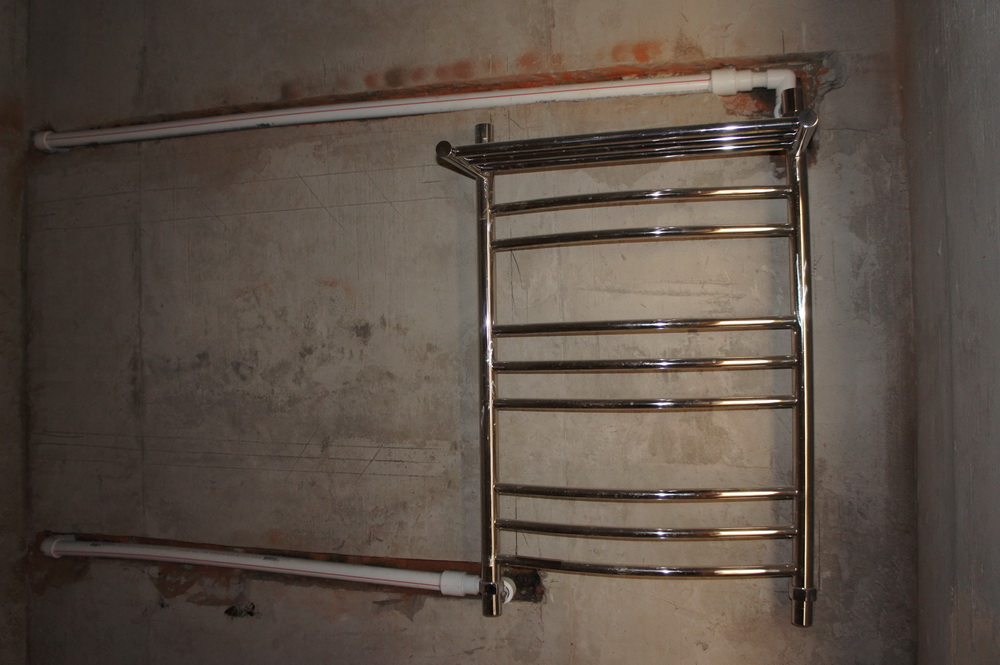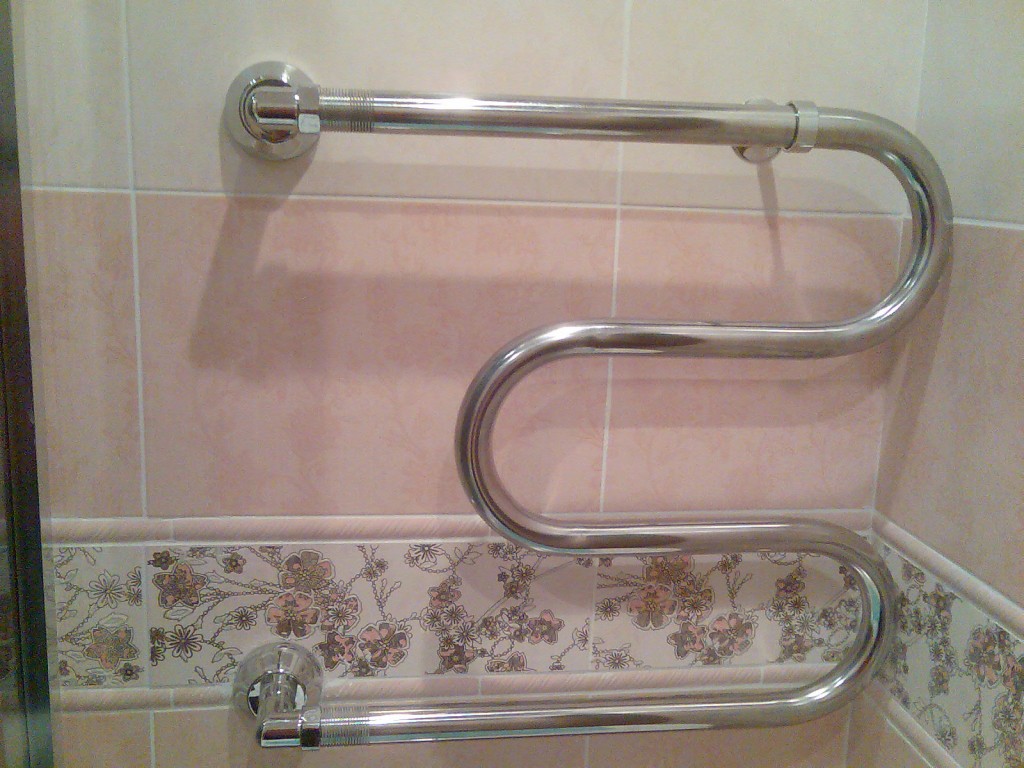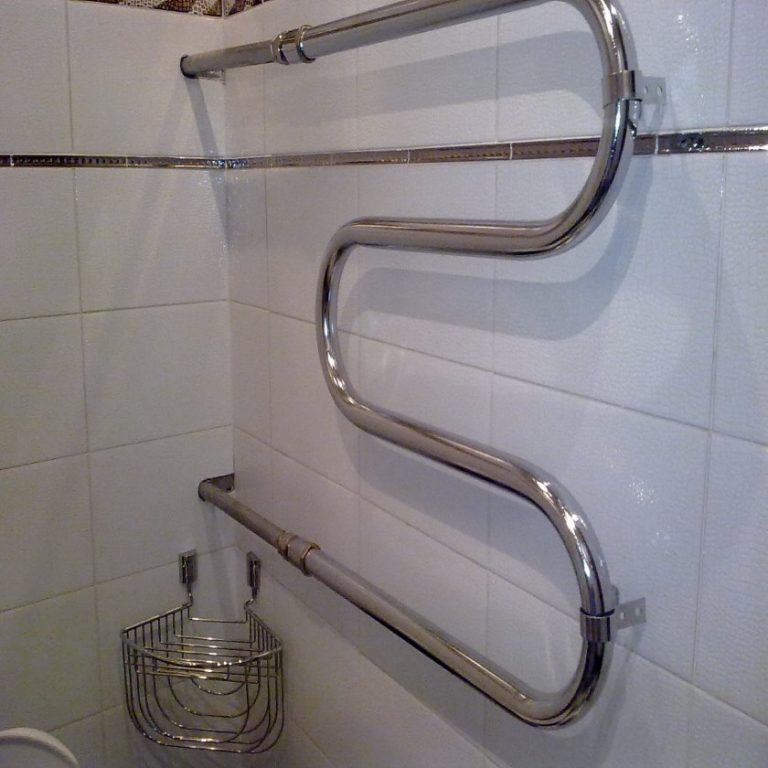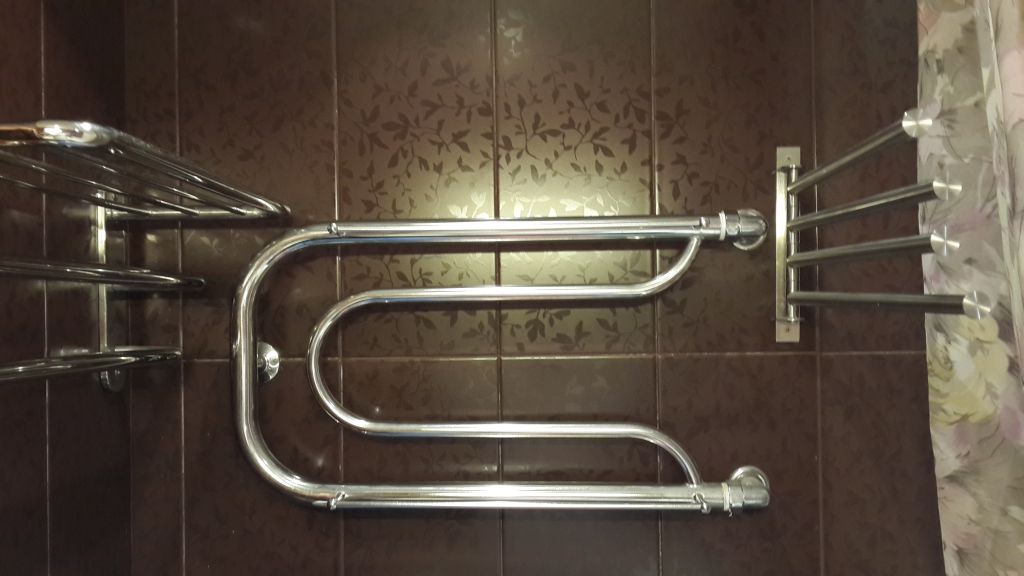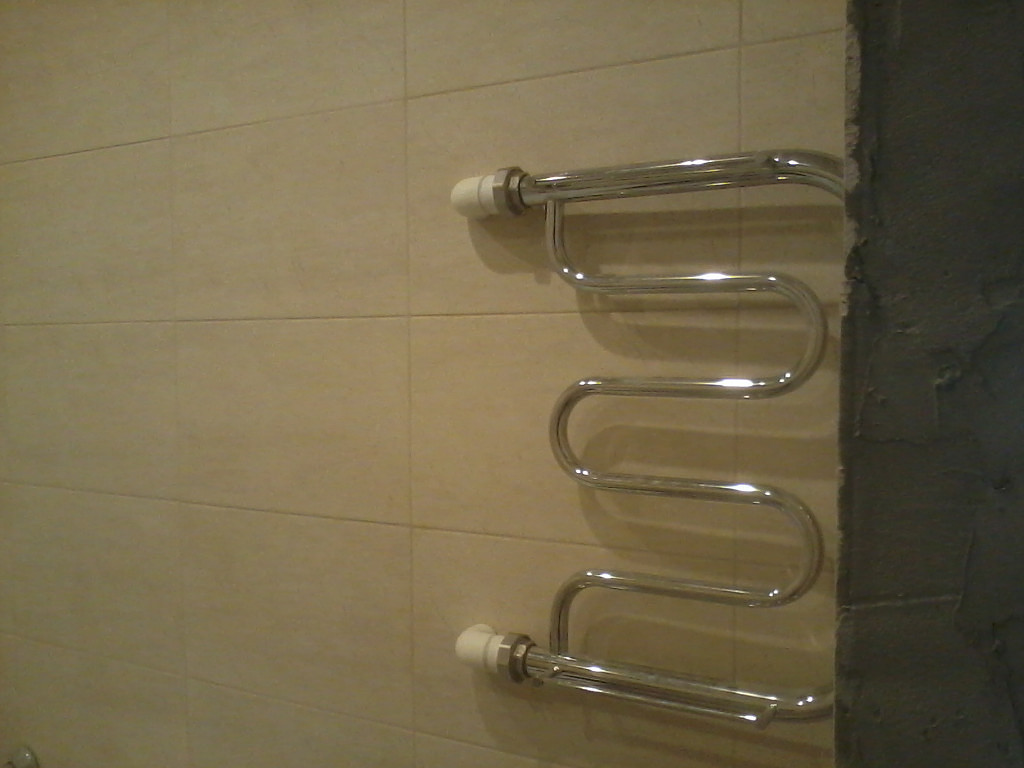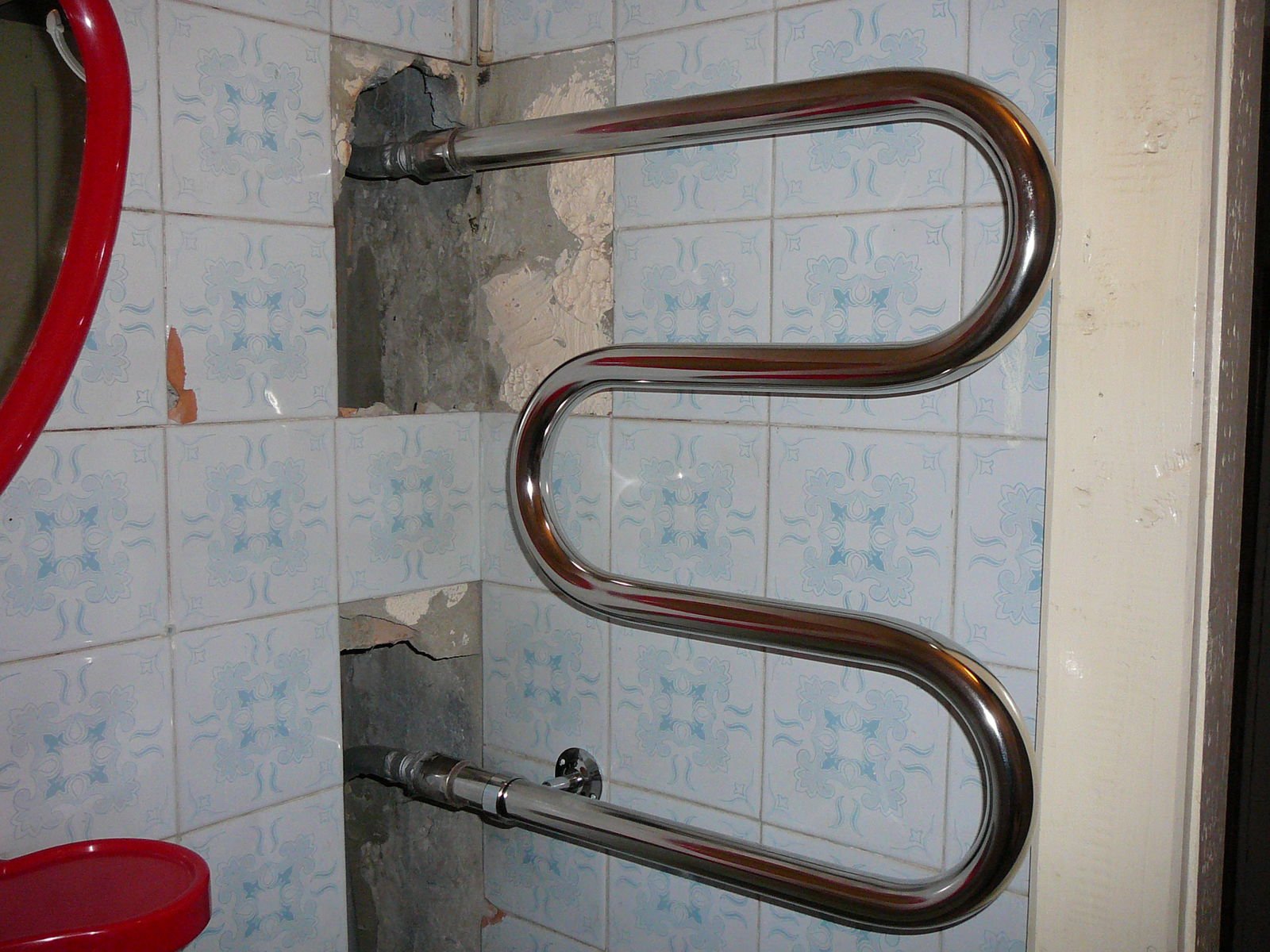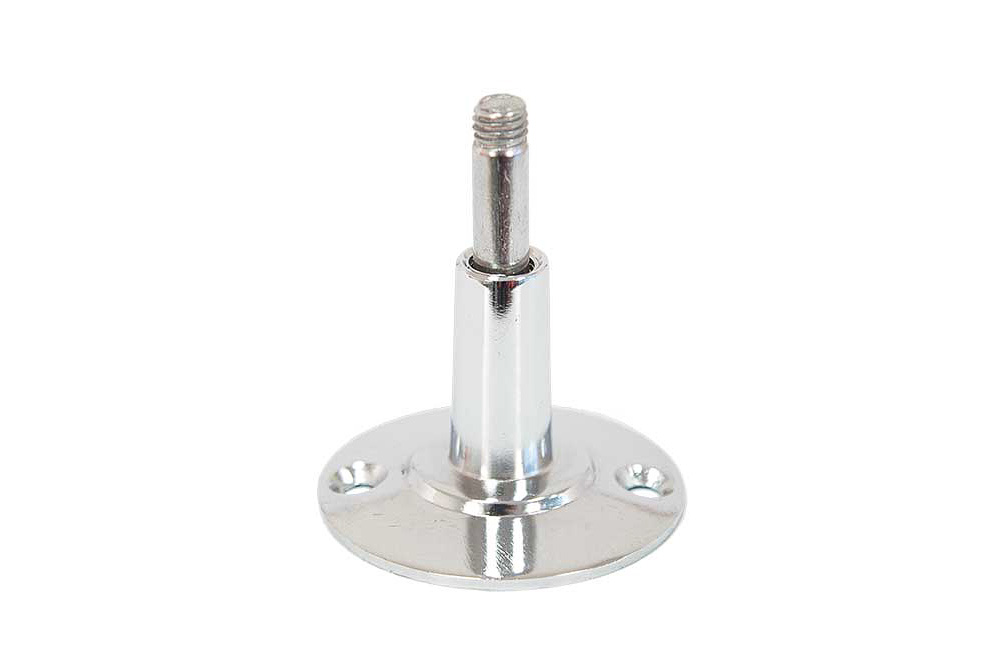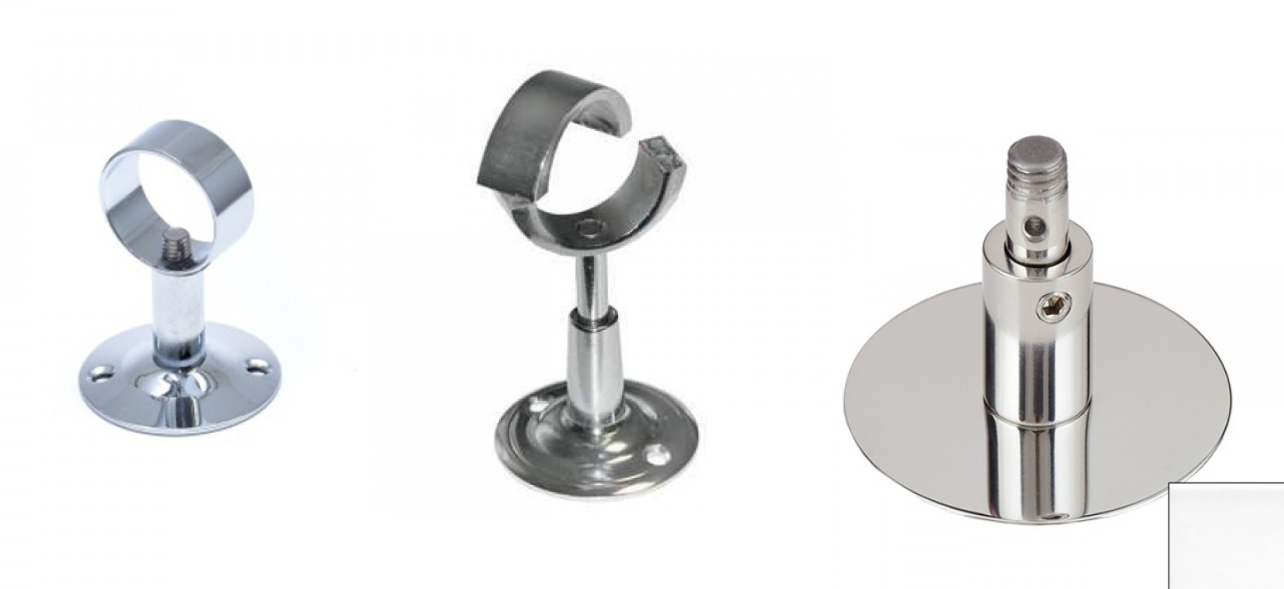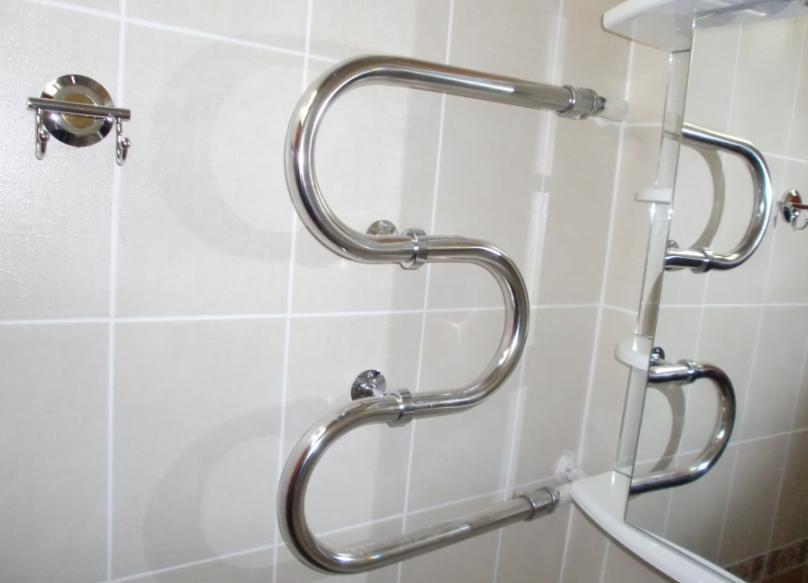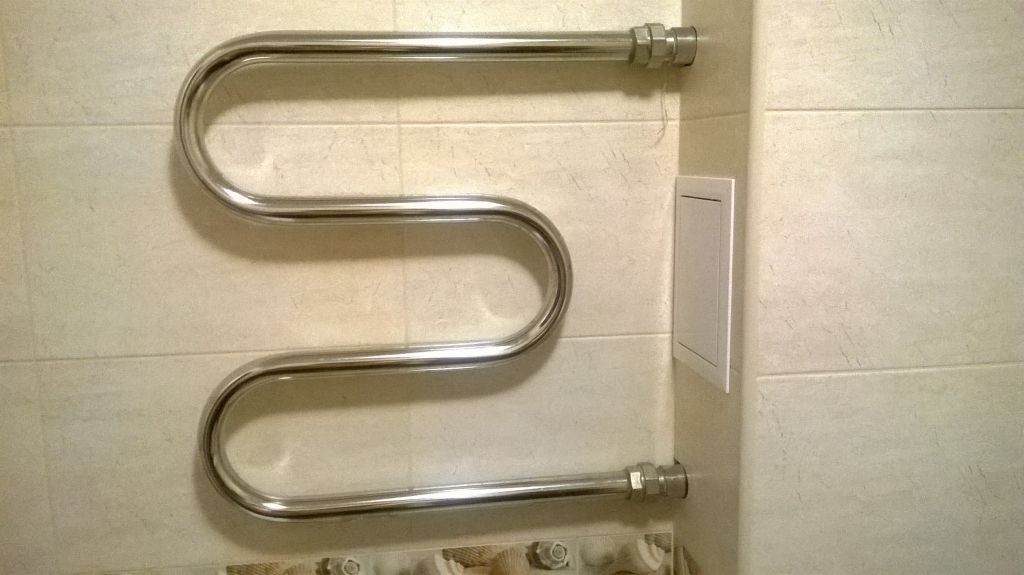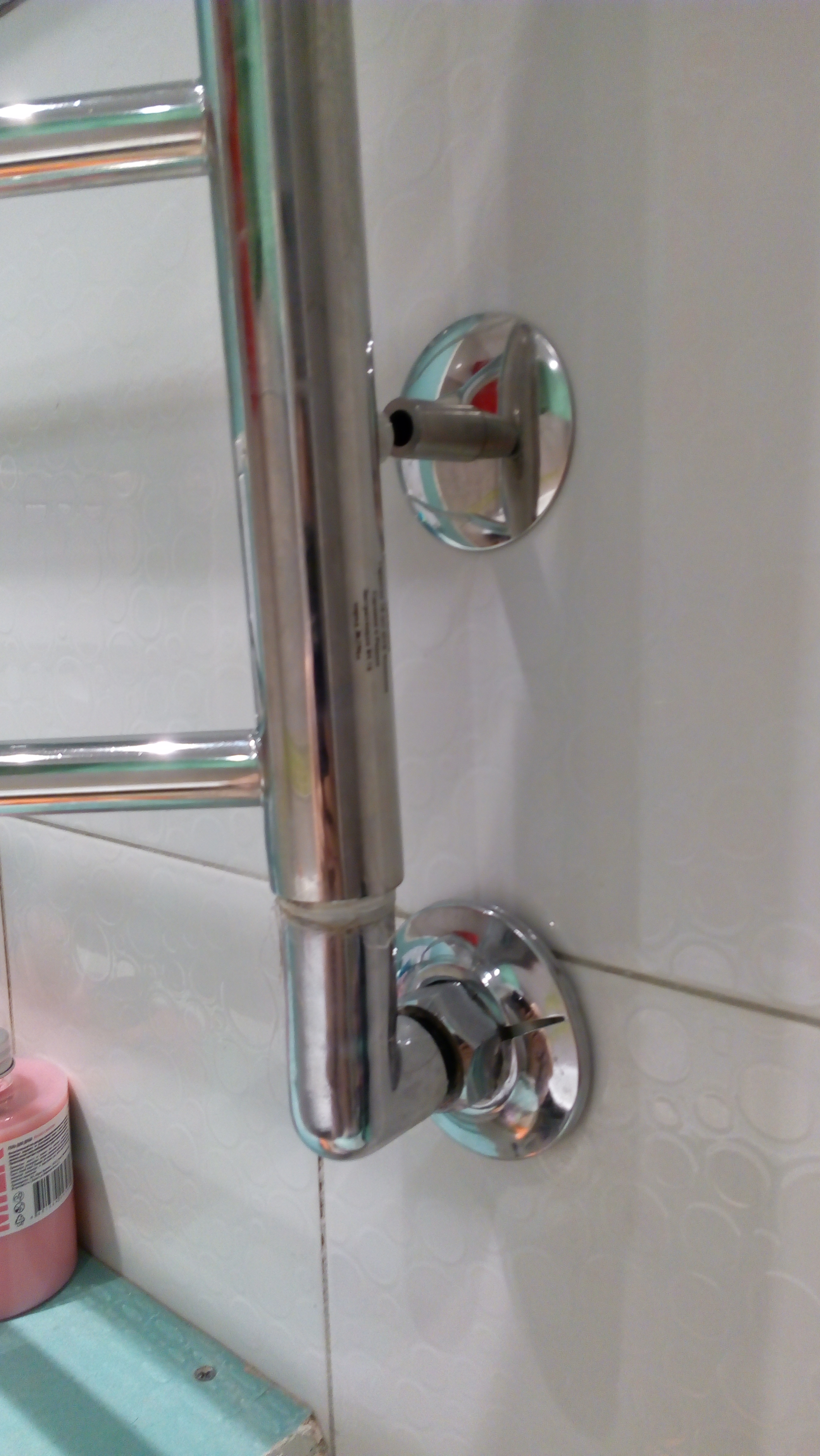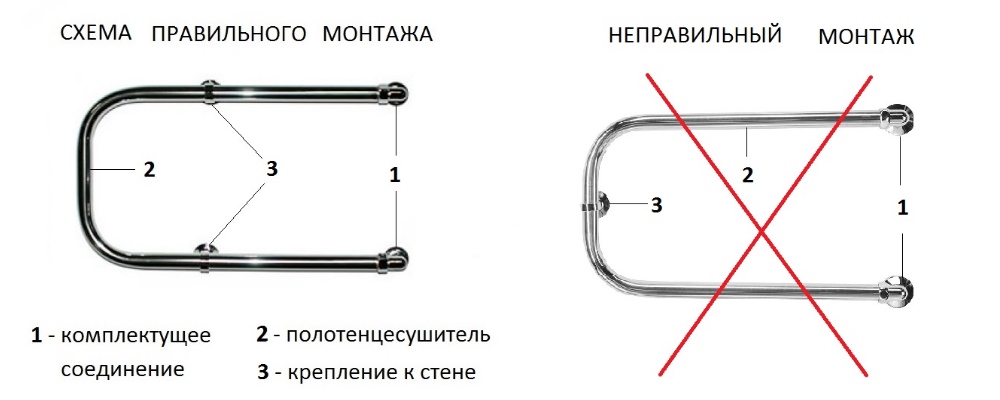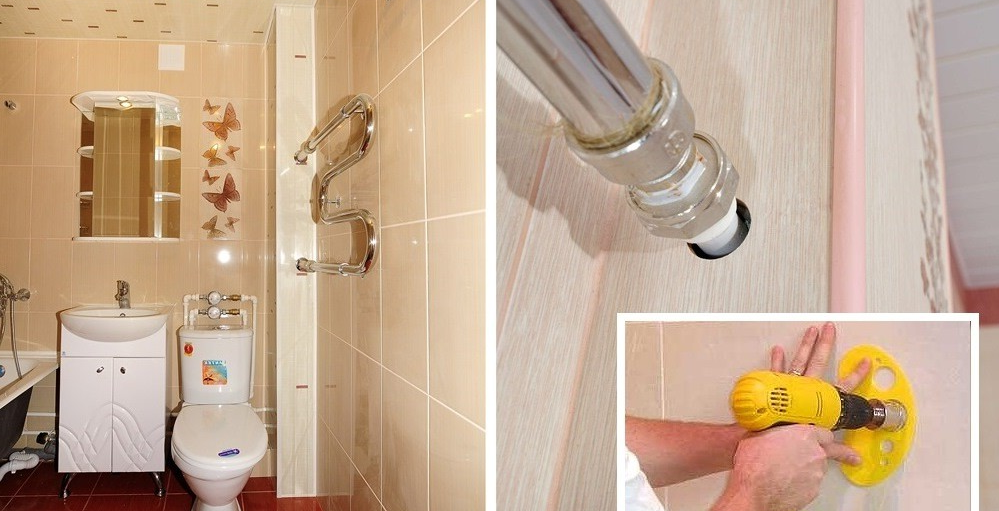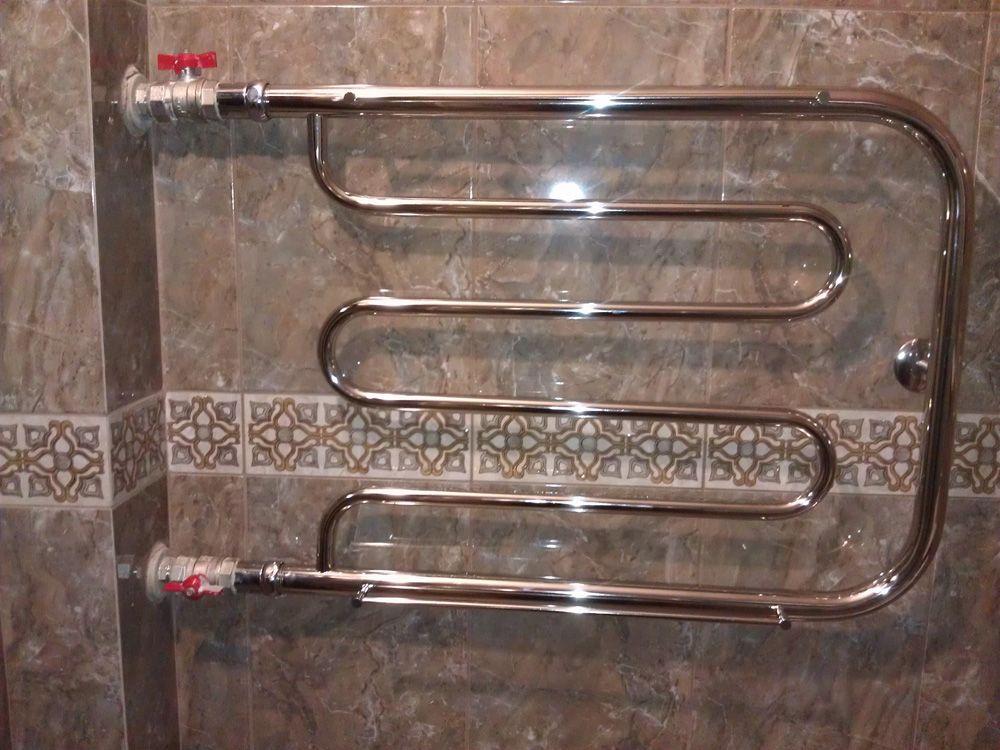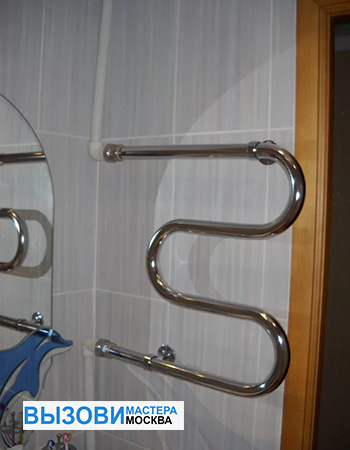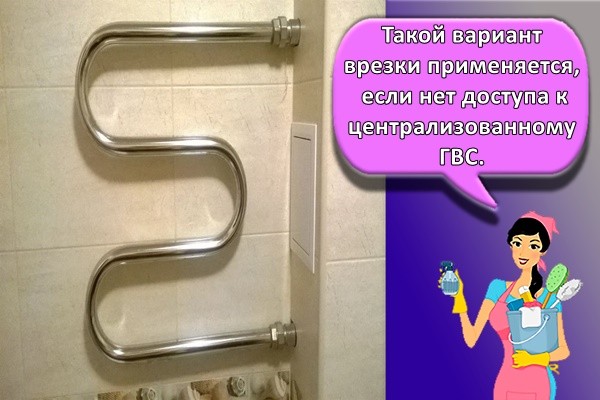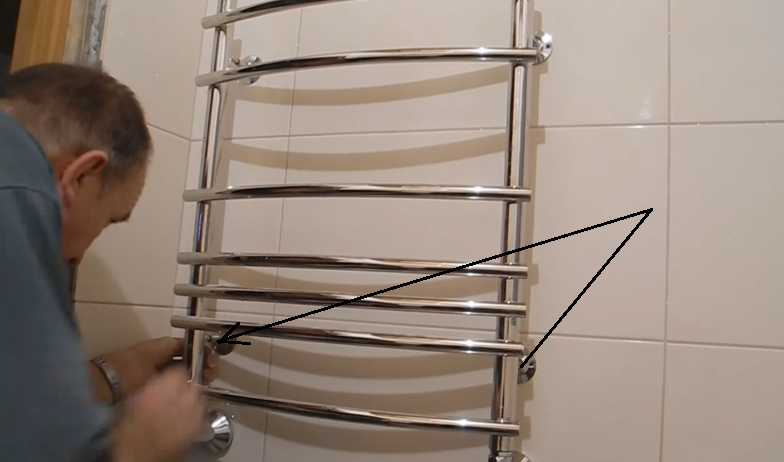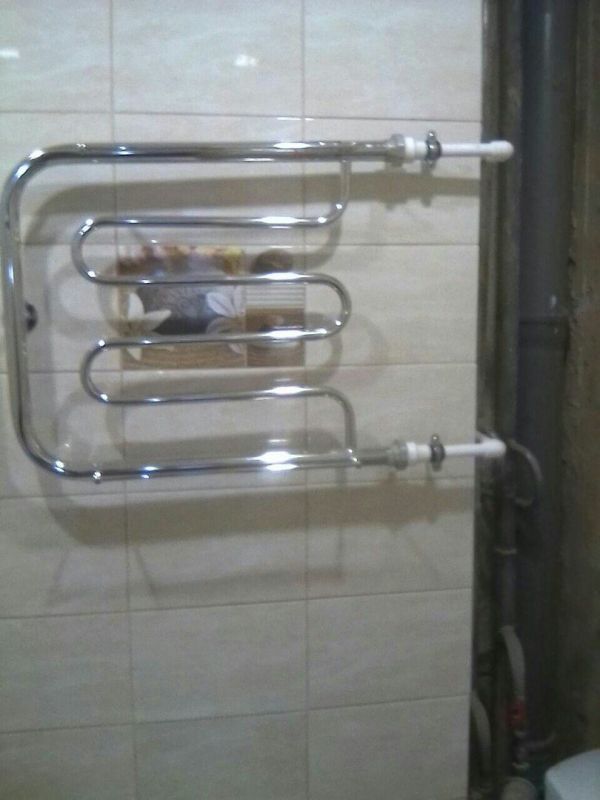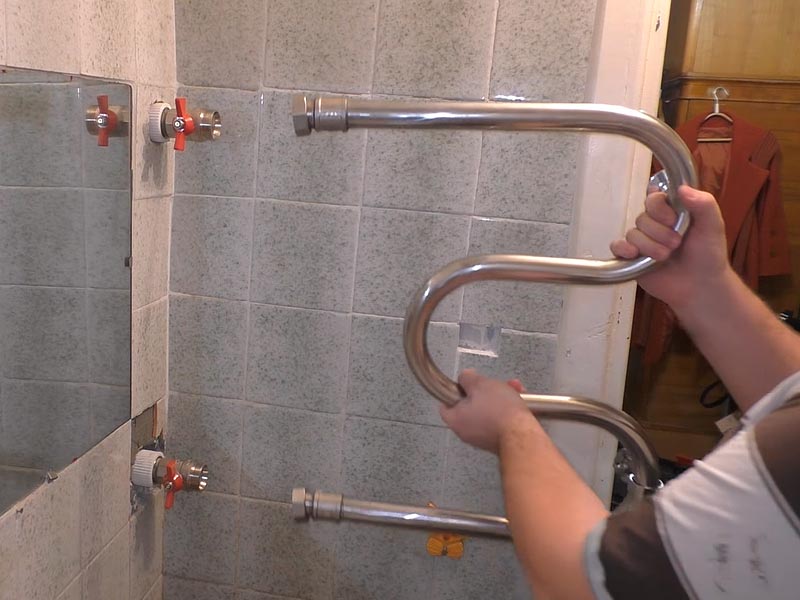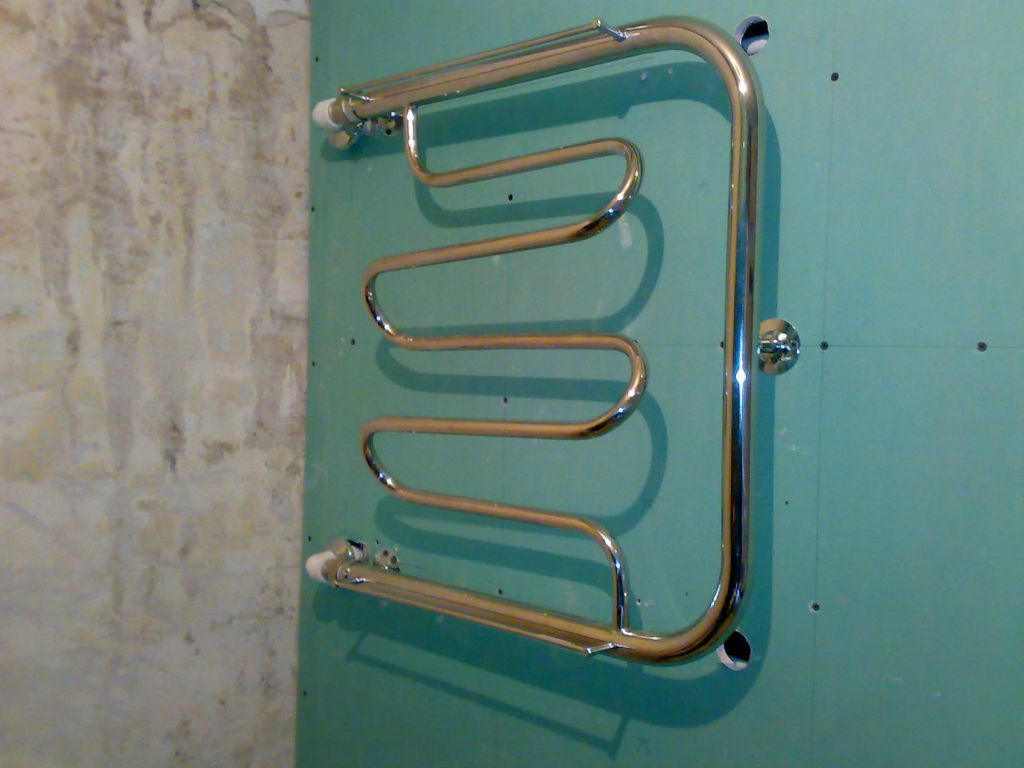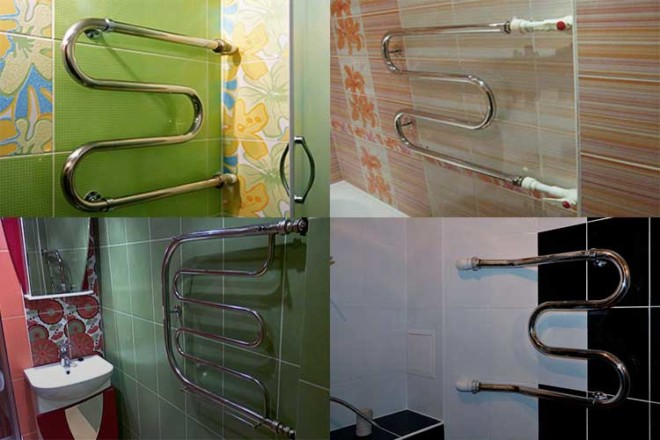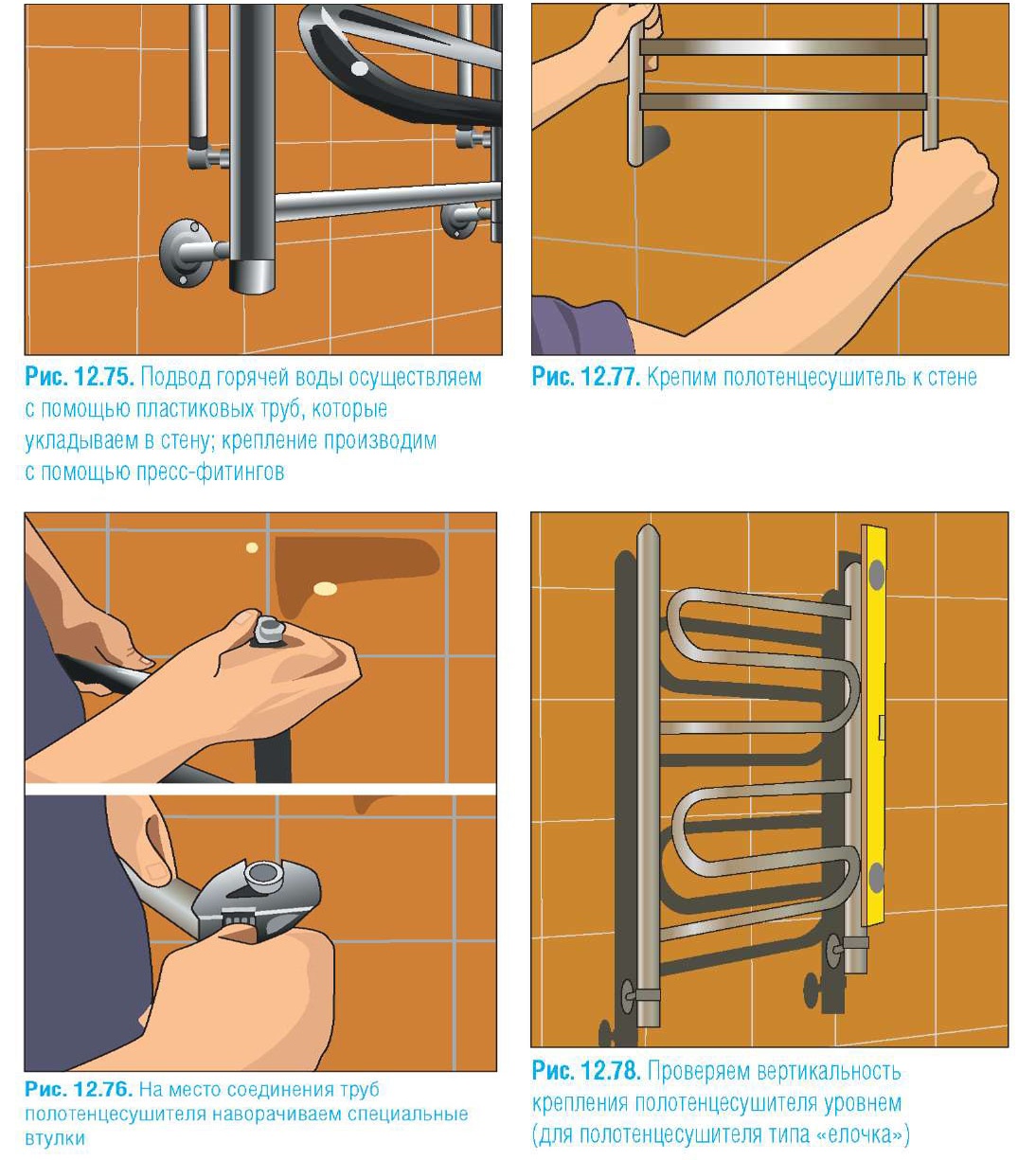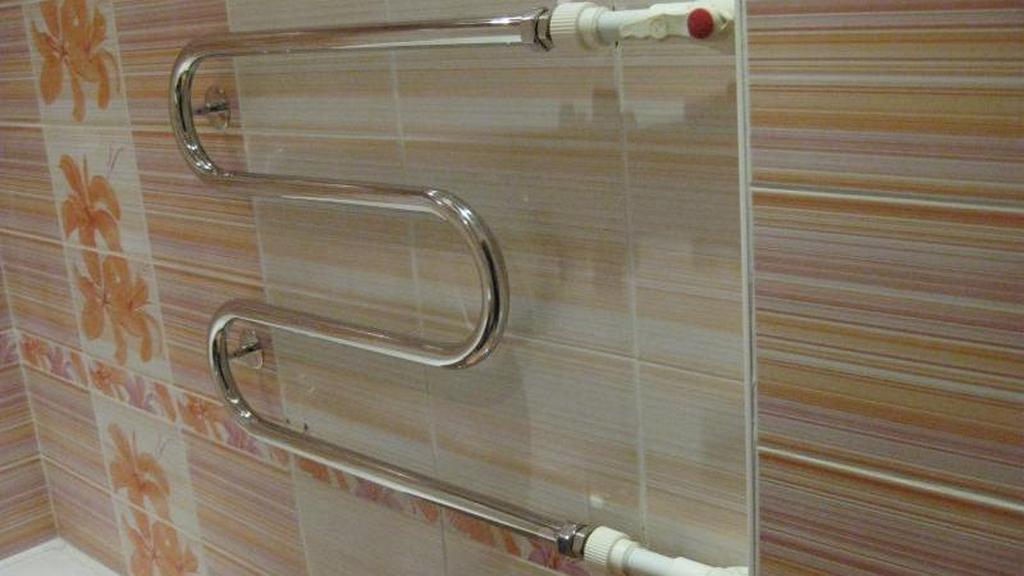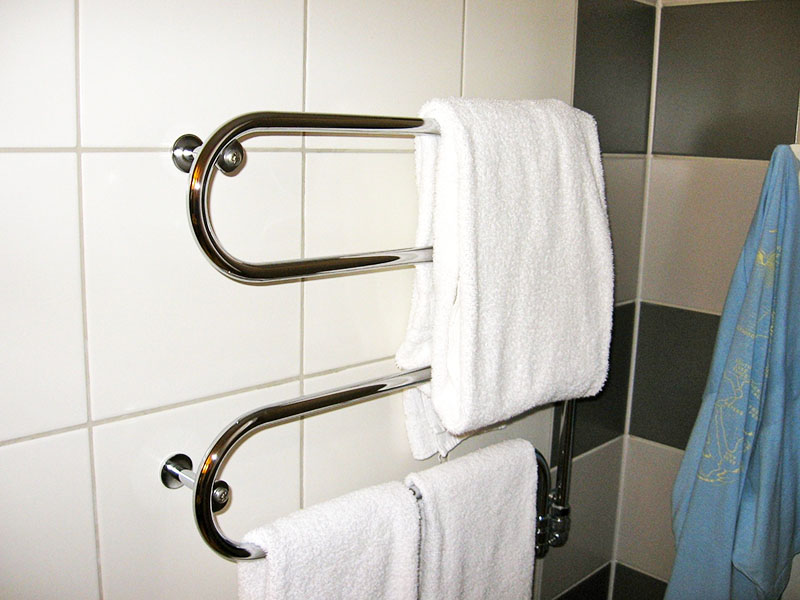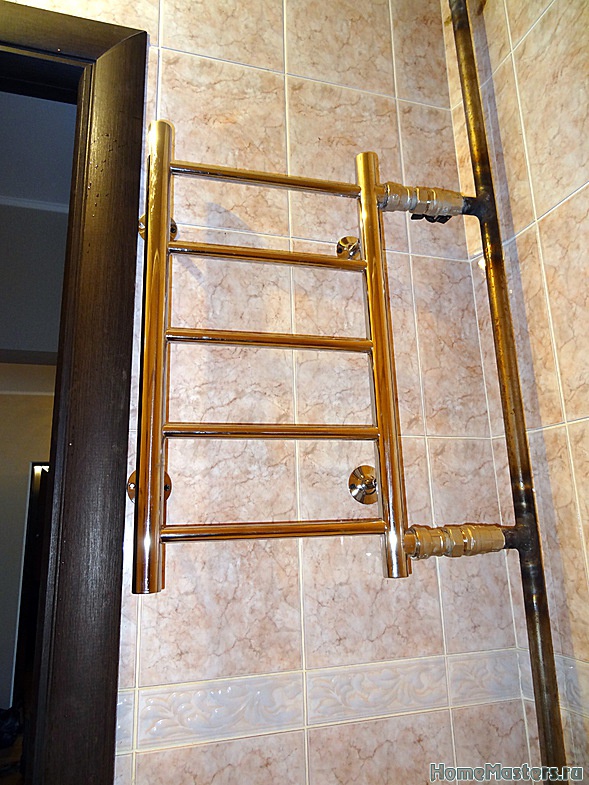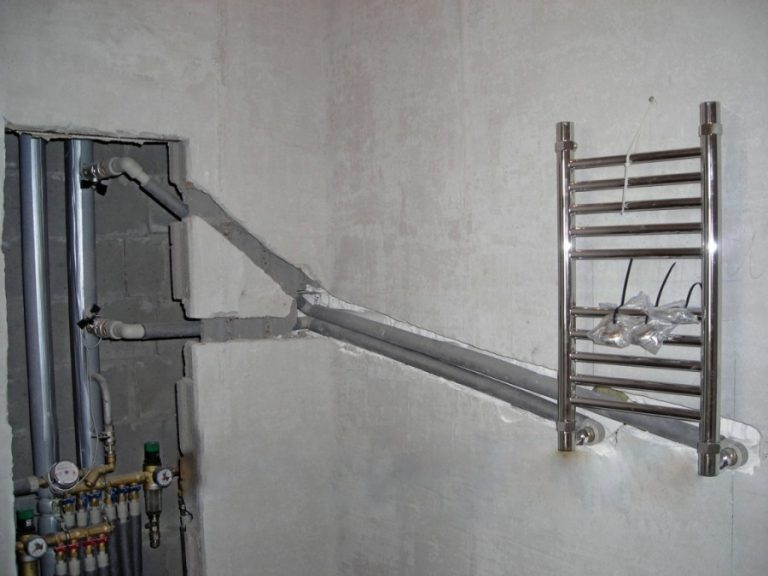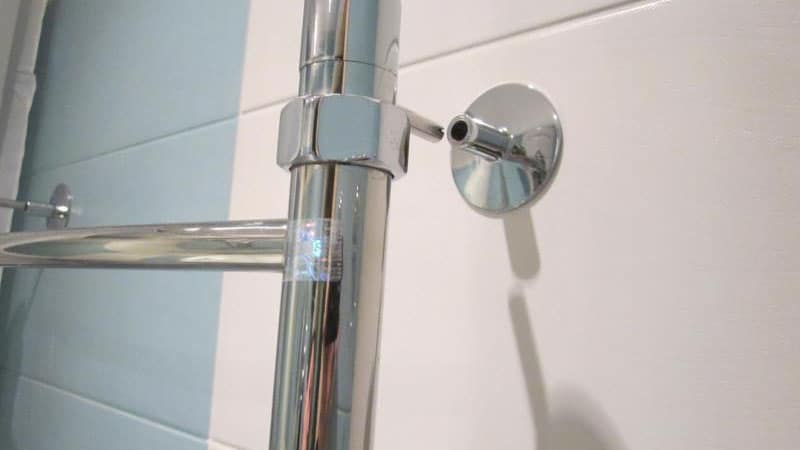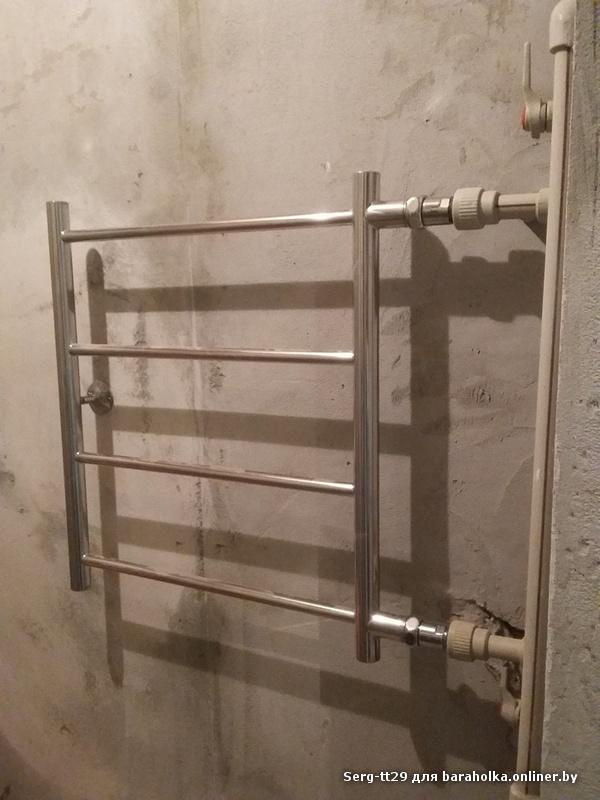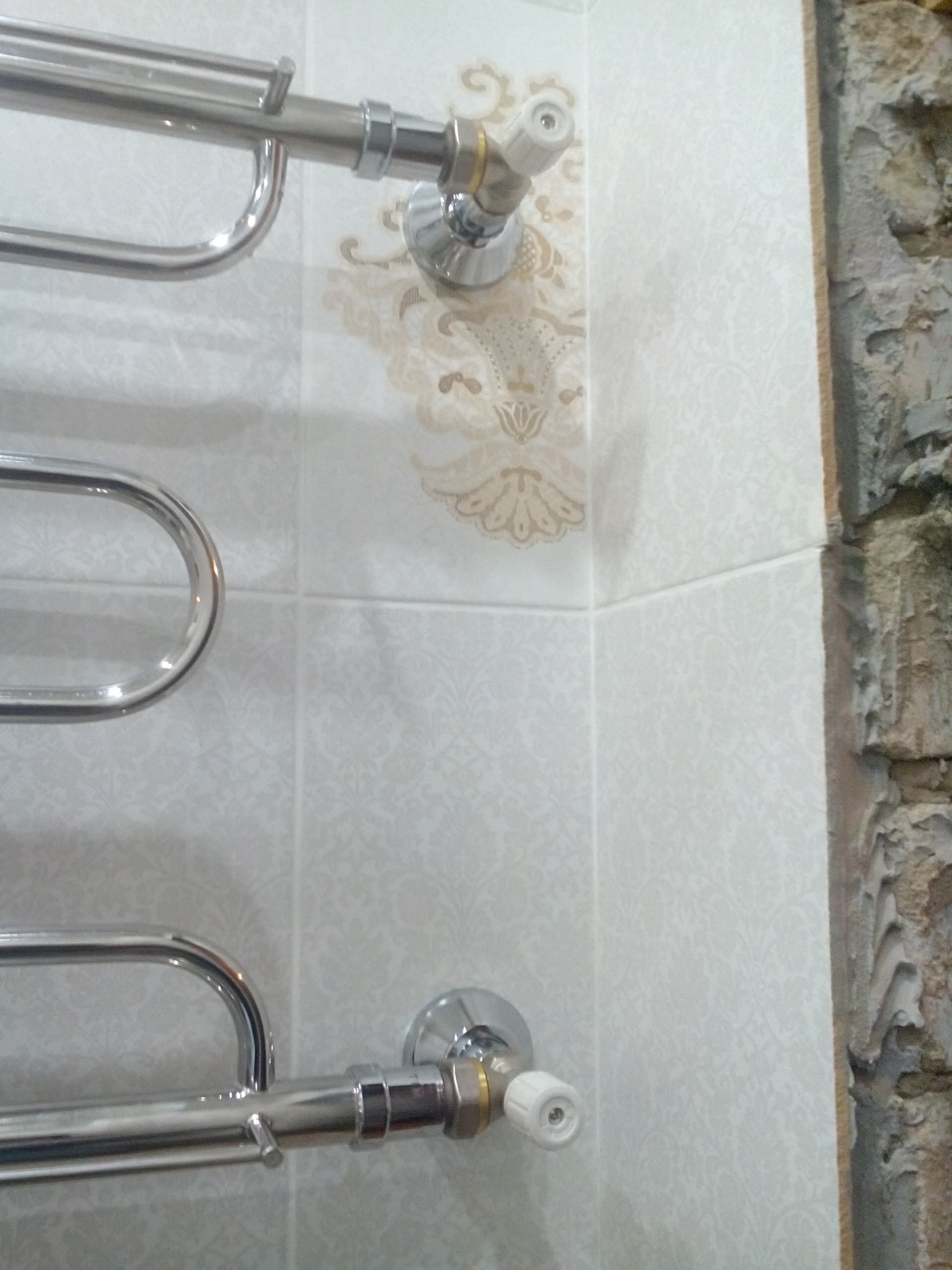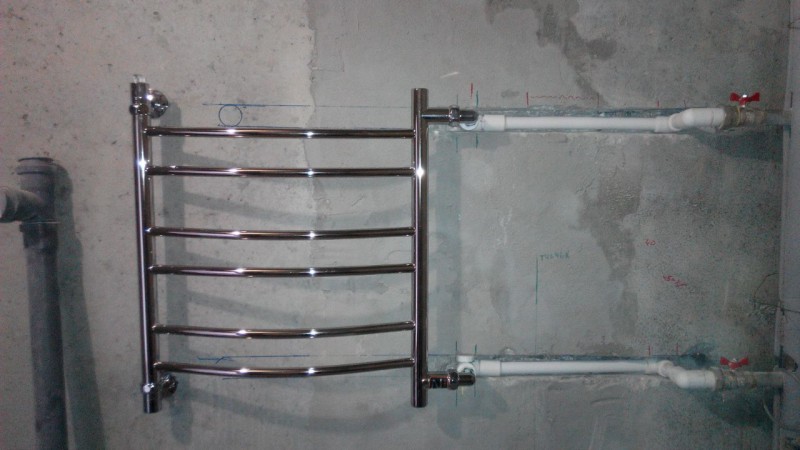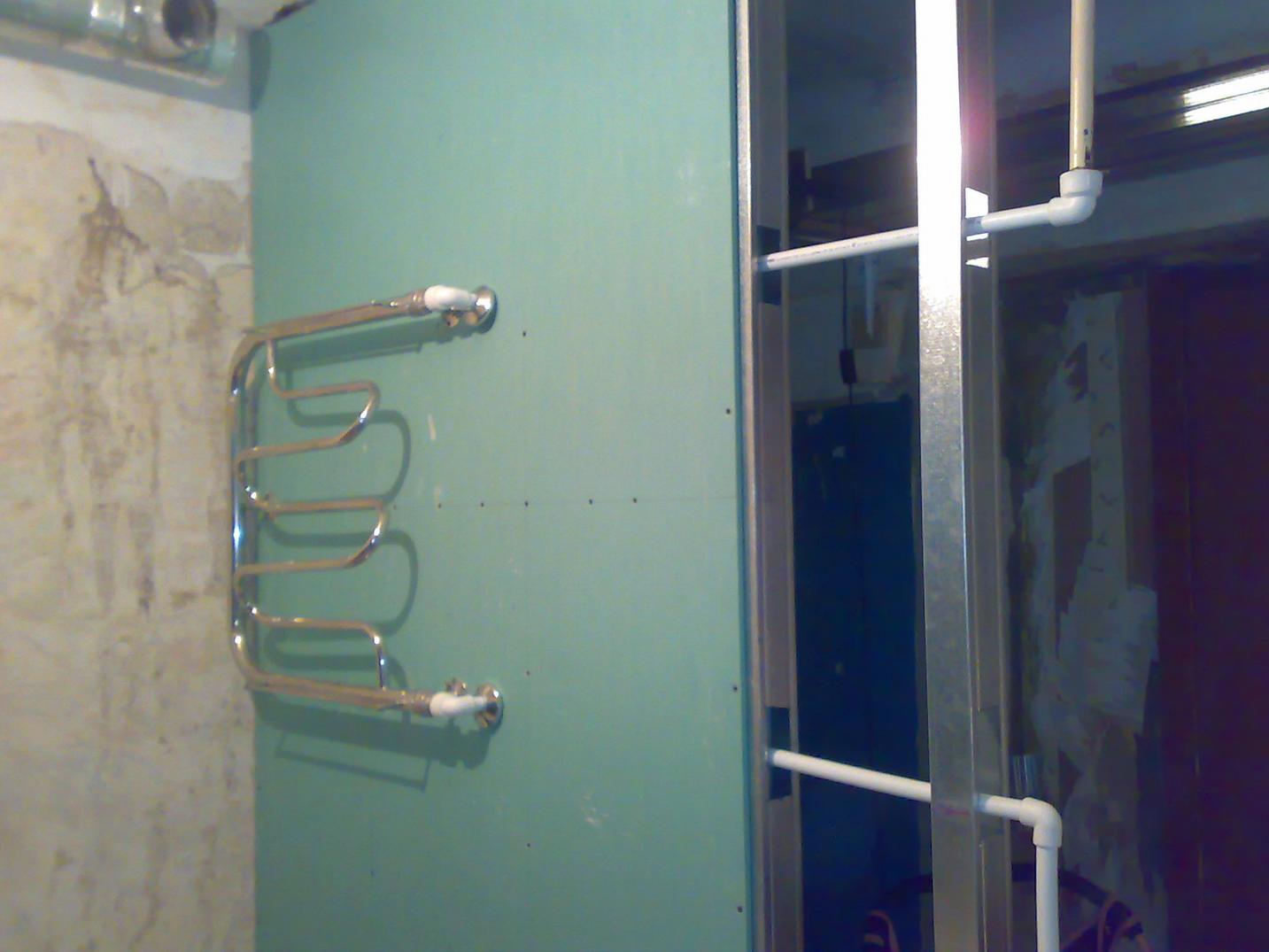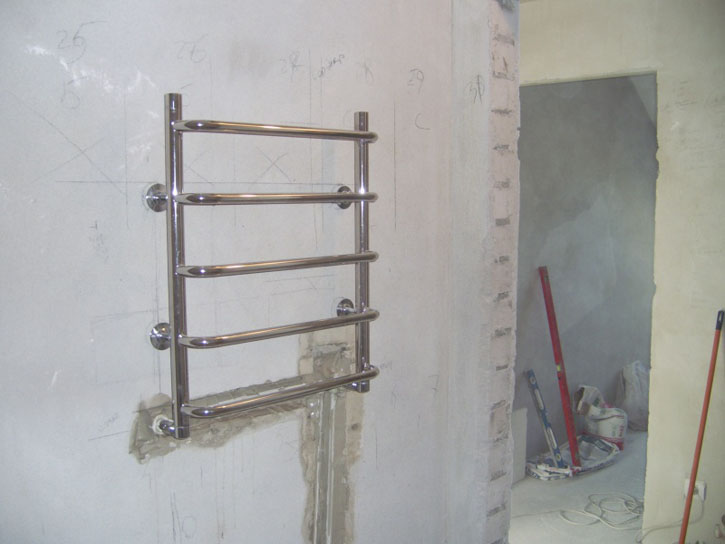Where to connect and where to hang
You can connect a water heated towel rail to both the hot water riser and the heating. If both of these options are available, DHW is usually selected.
There are three reasons for this: less hassle with permission to connect, you can connect at any time of the year (agree with the management company to disconnect the riser and that's all) and, most importantly, such a heated towel rail is heated all year round
If there is no hot water supply in the house, you will have to connect to the heating riser. This requires a UK permit and a project. Buy a heated towel rail (preferably a simple design), go to the housing office with his passport (copy), write a statement. If permission is given, you order a project (you will also need a copy of the passport with connecting dimensions). Then, according to the project, you do it yourself or hire performers (plumbers from the housing office, as an option). Call the representatives of the housing office for acceptance.
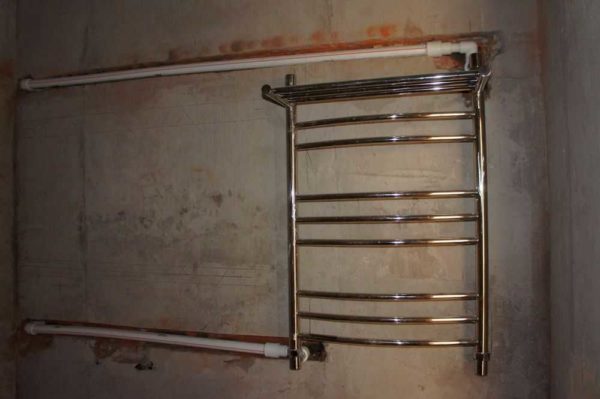
To keep the "towel" warm always and without problems, all carts are straight, without arcs and pockets
When determining the installation location of the heated towel rail, questions may still arise about at what height it should be hung. If you have a choice, it is most convenient to position it so that it is at head level and below. This is if you put a U-shaped or snake. If we are talking about "ladders" of great height, the upper bar is not placed at the glow level of the raised hand (about 190-200 cm).
When choosing a place for installing a heated towel rail, you must also take into account the distance from the riser. In principle, the closer to the riser, the better - the more chances that it will work. But, it can be attributed to a meter or so, only if the conditions are met:
- low hydraulic resistance of the heated towel rail (simple shape and section 1 ″ or 3/4 ″),
- sufficient pressure (2 atm or more)
- outlet with pipes of normal diameter (one step less than the riser).
In this case, it is imperative to follow other connection rules. Then there will be chances that such a "remote" device will work normally.
Combined model - installation and connection of a heated towel rail
Competent approach and improvement of an existing water dryer is a way to save money. Equipping it with a cable with a thermostat wound inside, we get a combined towel drying system, the operation of which does not depend on the season. Connecting a heated towel rail is carried out only as needed, and this is a significant savings. The safe operation of an electric dryer is subject to several requirements. The power line of the tubular electric heater (TENA) is supplied to a separate outlet, since its power consumption is quite high - at least 1 kW. For this, a wire is used with a cross section of at least 2.5 mm. The connection diagram for a heated towel rail is carried out using an automatic fuse, which is an integral part of it.
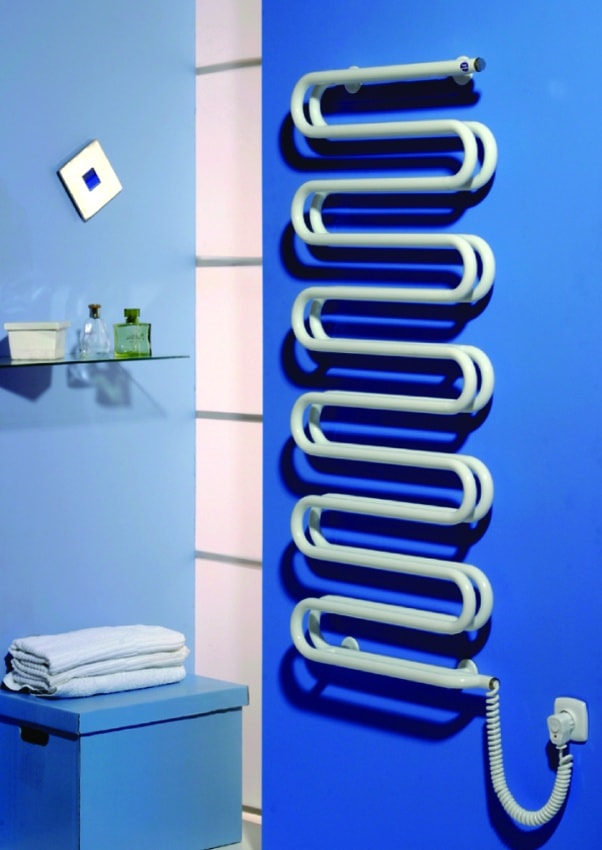 Attaching a heated towel rail to the wall photo
Attaching a heated towel rail to the wall photo
Another important point that guarantees the safe operation of the device is grounding. Its fastening is usually provided by the manufacturer. It remains to mount the socket, from which we lay a three-core wire into the distribution board. If for some reason it is impossible to produce it, grounding is provided.
Note
Do-it-yourself installation of an electric and combined heated towel rail in the bathroom is a certain risk associated with working in hazardous conditions. For the correct execution of all tasks, certain skills and knowledge in the energy field will be required. The risk in this case is not justified and it is better to contact an experienced specialist if there is no confidence in the high-quality performance of all the work with your own hands.
Some connection features
The most popular mounting method is the threaded connection. It is easier to implement. More experienced craftsmen will provide for the installation of three taps: two on the heated towel rail itself, and the third on the "bypass" system. This will help in the future, if a leak occurs in the system, turn off only it, and not the entire water supply system. The bypass is especially relevant when installing with the help of "American women". They contain silicone or rubber gaskets, which have a limited service life and therefore require periodic replacement.
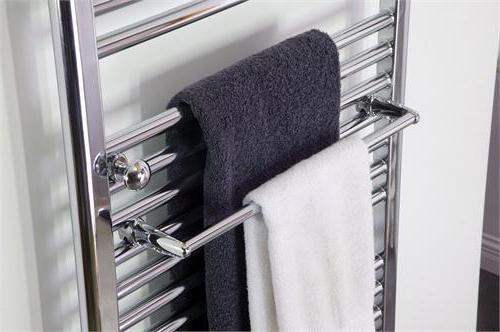
The choice of the fixing system depends on the model, technical capability, and the availability of the available supply system. Installation with a threaded connection can be done by hand. But at the same time it is better to provide for a "bypass" system and shut-off valves. This will help in the future to avoid big troubles when loosening the attachment point. Additional fasteners will help secure the system to the wall, ultimately reducing stress on the fittings.
Bypass Installation Rules
With a sequential tie-in to the bypass, it is forbidden to put a shut-off valve, therefore, 2 valves are taken. In other cases, they put 3 taps - one at the entrance, another at the exit, the third on the jumper. The bypass is placed between the inlet and outlet of the heated towel rail. When installing it, tees are used. For sealing, tow or tape sealants are used.
The bypass is installed sequentially:
- Tees are attached at the inlet and outlet of the outlet from the riser;
- Install the tee of the ball valve at the outlet of the branch;
- Fix the second end of the jumper at the outlet of the tee on the return pipe.
Install ball valves on tees and connect them to the outlet and inlet openings of the device. All joints and connections are sealed with silicone sealant.
A heated towel rail is an indispensable tool for the bathroom. With its help, the most comfortable atmosphere in the bathroom will be established, towels and clothes will always be soft and dry. Installation should always be carried out according to the instructions, then the use of a heated towel rail will not cause any problems and hassle.
Non-standard ways
In addition to the standard, well-known methods of mounting shelves, original options are used using various materials at hand. These details allow not only to conveniently and easily fix the structure, but also act as a decoration.
Hook rings
You can hang the shelf using rings with attached hooks. The rings are attached to the wall, and the hooks are hooked to the hinges previously screwed into the fabric of the structure.
Water pipes
The method will come in handy in any room. Holes are made in the fabric of the furniture slightly larger than the diameter of the water pipe. The shelf is "put on" and fixed with a flange in the desired position. The structure can consist of one panel, or it can be an open rack.
Belts
The shelves, suspended on belts, look original. To do this, take two leather products of the same length, fold them in half and drill them to the wall. A shelf is inserted into the resulting loops. To prevent the canvas from moving, the belts must be screwed with small screws to the shelf.
Ropes
Shelves hung on ropes will look great. For this, a thin rope is used. 4 holes are made in the tree, through which the rope is threaded. Knots are tied on both sides, so the shelf is fixed. The ends of the ropes are tied together and attached to the wall.
Hidden fasteners in books
The shelf is an old book with a metal corner screwed into it. The second part of the mount is fixed to the wall. Such a shelf will hold several more books.
Step-by-step installation instructions
Since the heated towel rail is mounted directly into the water supply system, it is very important to ensure that the device functions correctly.If mistakes are made in the work, then not only the drying itself, but also the water supply system may suffer.
If mistakes are made in the work, then not only the drying itself, but also the water supply system may suffer.
In general, the installation process is not difficult. And it consists in the following: we supply water to one side of the device, and from the other end we ensure its outflow.
- We choose the best connection option: to the heating system or to the hot water supply line.
- It is necessary to dismantle the old equipment. To do this, turn off the hot water supply.
After she leaves the riser, remove the old dryer.
If it is welded to the pipe, cut it off with a grinder.
The remaining portion of the hollow object should be sufficient for threading.
We mount a bulkhead (bypass) and ball valves (valves). What does jumper installation involve?
Ball valves are mounted at the ends of the heater (if necessary, they will interrupt the flow of liquid).
The bypass is equipped with three valves.
Two of which are installed at the points of connection of the heated towel rail to the jumper, and the third is inserted into the bypass.
This will allow the working fluid to circulate freely through the radiator.
It is very important to control the evenness of the pipes.
Install the coil. First of all, we attach the brackets to the walls.
Then we hang a heated towel rail on them. Sometimes you have to gouge the walls.
Then we connect the drying to the valves on the lintel (bypass). Fittings and bushings can be used for these purposes.
After installation, you need to smoothly open the taps, the coil will be filled with water gradually. This will minimize the risk of water hammer.
Everything, this is the end of the work. Are you wondering how much it will all cost? It makes no sense to talk about specific numbers.
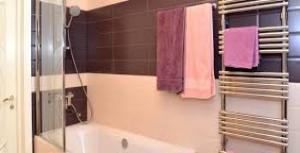 Much depends on the complexity of the work performed, the type of coil selected, etc.
Much depends on the complexity of the work performed, the type of coil selected, etc.
Pay attention to the maximum distances between the wall and the heater, which must be strictly observed:
- 5-7 centimeters - if the pipe diameter is more than 2.5 centimeters
- 3.5-4 centimeters - with a pipe section of less than 2.5 centimeters.
In order not to expose the walls to heavy loads that can be triggered by thermal deformation of a hot galvanized water pipe. the structure cannot be rigidly fixed.
The coil is hung on the mounting brackets.
After completing all work, you need to check all connections for leaks. If you find a leak, it must be repaired immediately.
Connection methods
There are several options for connecting a heated towel rail to the water supply system:
- Threaded. The simplest and most popular type. It allows you to change outdated equipment in the future. Weak point - the fastening may weaken over time. But by tightening it in a timely manner, the problem can be eliminated.
- Flanged. Possibility to connect without threading at the outlet of the heating system. Weak tightness compared to other types.
- Welded. This is one of the most reliable types in terms of tightness. Disadvantages - over time, in the place of the seam, rust can break the tightness, if it leaks, it is difficult to repair. And if the system is also connected to the heating system and the accident occurred during the season, then difficulties in disconnecting and repairing will be added.
- Crimp. For this, a seal insert (crimp ring) is provided. Can be attributed to stationary connection methods. Connection to the heating system is not recommended.
Difficult cases
There are a number of cases where fixing shelves to the wall requires care, some effort, or the use of more durable materials.
How to hang a glass shelf
Glass shelves are mounted on brackets. The fasteners are fixed to the wall with ordinary self-tapping screws, and are closed from above with decorative overlays.The glass is clamped between the two bracket parts using a squeezing mechanism.
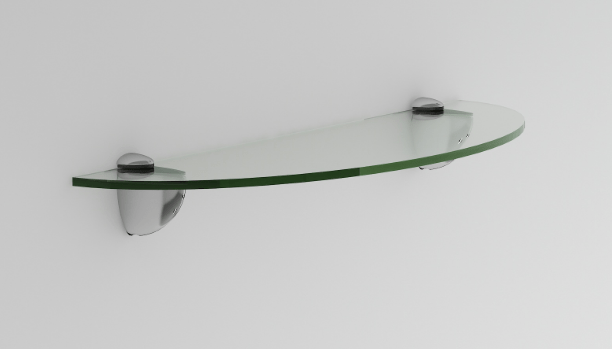
On a plasterboard wall
For a solid installation of shelves on a wall made of gypsum fiber board, it is necessary to make mortgages of metal or wood at the installation stage. In this case, the fasteners will be screwed to the strong material and hold the structure tightly. If the wall is hollow, it is better to install the shelf using umbrella dowels.
Concrete wall
A feature of a concrete wall is its strength, so drilling will be required to install the shelf. For this, a perforator and a strong drill of a slightly smaller diameter are used than the dowel-nails will be used.

How to properly install a heated towel rail in the bathroom: choosing a device
In order to properly mount the device, first of all, you need to decide on the choice, because the specifics of placement in the bathroom also depend on the model.
Today there are three main types of heated towel rails - these are:
- Water devices;
- Electrical analogs;
- Mixed devices.
Each type has its own characteristics, so we propose to consider the strengths and weaknesses of each separately. The most common heated towel rails are of the water type, which are simply part of the heating equipment in the house. In the bathroom, pipes are being installed through which hot water circulates during the heating period. If we are talking about the heating season, then you can use a heated towel rail, but at other times of the year it will not be able to perform its functions.
The second type of devices is the most popular on the market - these are electrical counterparts. Mounting is done on the bathroom wall, while the installation height can be adjusted to suit specific needs. The device works from an ordinary socket and heats up special metal rods on which you can hang damp laundry. For installation, it is enough to think over reliable fasteners and provide the device with access to electricity. Usually, you can hang an electric heated towel rail with your own hands, however, if the fastening involves bringing the electrician to the desired point, then it is better to entrust the work with the wiring to a professional.
Mixed-type appliances are a cross between electric and water heated towel rails, they run on electricity, but they have access to a water supply system and can switch to water type of heating. Convenience is that at the end of the heating season, you can switch to an electrician and use the device further.
At what height should the heated towel rail be hung correctly?
There are certain SNiP standards that regulate the installation of equipment of this type, such as heated towel rails.
The installation of a heated towel rail must be carried out at a distance of 120 cm from the floor level and away from all nearby objects, such as a bath, sink, shower and other plumbing equipment, at least 60 cm.
In this case, the heated towel rail can be located directly above the washing machine, and so that it does not interfere with the free opening of the lid of the machine with a front-loading type of load.
If a ladder-type heated towel rail is mounted, then it should be located at such a height that an adult has free access to the top bar of the dryer.
the system chose this answer as the best
There are no requirements for height in any regulatory document, if I am wrong, then indicate the document number and the chapter that says how far the heated towel rail should be installed from the floor.
There are only recommendations from specialists, and then they lead more to two characteristics:
- Ease of use.
- Bath heating.
Although it is clearly stated everywhere that a heated towel rail does not belong to heating systems, it is more intended to maintain a microclimate in such a humid room as a bathroom.
And since it does not apply to heating systems, it means that there is no special law for its height from this side.
Read Corner between tiles and bathroom
All refer to plumbers' handbooks, which were written back in the 50s and reprinted in more recent years.
So in these reference books there are recommendations for the bottom, which should be at least 60 centimeters, i.e. the lower, the more space it will warm up.
Now such heated towel rails are produced, which are practically installed on the floor.
The requirements for installing a heated towel rail directly depend on its size, because, contrary to its direct purpose, not only towels are hung on it, but sometimes socks and socks, and their size and configuration are very different.
Naturally, when installing a heated towel rail, you need to take into account the convenience of the users, that is, install it so that you can easily reach for example from the bathroom or shower for a towel, take into account that things that have dried on it are not sprayed with water from the tap or shower, so that it circulates freely around them air and naturally so that they do not interfere with others.
The height from the floor must be chosen so that it is convenient for everyone, it is about 120 - 130 cm, but at this height you need to place the middle of the heated towel rail, both children and adults can reach it comfortably - the only thing that cannot be installed is a heated towel rail where there are electrical outlets on the wall , so as not to close and for safety reasons it will be wrong, pull with the plug from the hair dryer, pushing aside the wet towel.
add to favorites link thank
There are certain requirements, but to be honest, no one pays attention to them. Why? because modern heated towel rails are in themselves rather small products, the requirement is 120 centimeters from the floor (from its horizon), but how can this be done if the heated towel rail is one meter long, and the height from floor to ceiling, in the bathroom, is only 2.20? (there are some) answer: yes in any way (not to fix it under the ceiling)
I have been working in this area for many years and have never even heard that representatives from the ZhEK or another organization walk around with a tape measure and “look for” the very 1.20s. But if there is a desire to do everything according to the law, then at least 90 cm from the floor, and if the heated towel rail is above the bathroom, or a washing machine, then at least 60 cm from them (not from the floor). Even Soviet heated towel rails (if a curved pipe can be called a dryer) were attached at different heights, in other words there is a norm, but no one bothers about it.
add to favorites link thank
Installation of a water heated towel rail
The do-it-yourself installation procedure is to connect the inputs and outputs of the device to the heating system or hot water supply network. Moreover, the second option is the most rational, since hot water is available at any time of the year, while the heating system functions only in the cold season.
- Dismantling the old heated towel rail in the bathroom;
Before starting work, the hot water supply is shut off. This interim measure is coordinated with the relevant authorities in order to avoid unpleasant consequences. Having closed the valve, proceed to dismantling. We untwist all available threaded connections. If the heated towel rail is an integral part of the water supply system or the thread has stuck, we use a grinder to separate it. We cut the pipe correctly, taking into account the margin provided for further threading
Next, carefully remove the dismantled part from the brackets
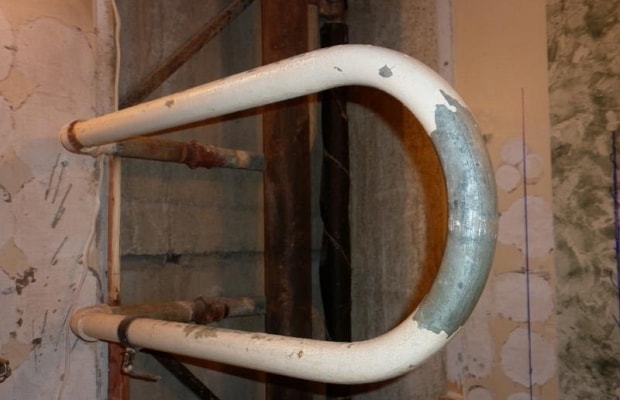 Dismantling an old heated towel rail with your own hands
Dismantling an old heated towel rail with your own hands
- Installation of cranes;
Taps are needed in order to regulate the intensity of the functioning of the heated towel rail. In addition, in the event of a breakdown, to eliminate malfunctions with their help, water is cut off for further repair work.If the pipes were cut and there is no thread on them, we cut a new one using a die of the required size. We restore the old thread in order to ensure a reliable connection of the parts. Only after that do we start installing the cranes with our own hands. If necessary, the bypass system is installed at the same stage.
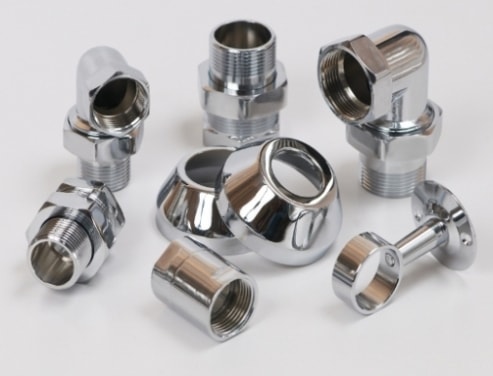 Fittings for connection
Fittings for connection
- Installation of a new product;
At this stage, you will need fittings (angled or straight) .To seal the connections, use linen winding or FUM tape for tapered threads
Next, we attach the heated towel rail to the wall using special holders or clamps and carefully connect the input and output to the fittings, carefully tightening the fasteners
It is very important to maintain the correct installation distance from the wall. The heated towel rail is fastened to the wall at a distance of at least 3.5 cm for pipes with a diameter of up to 23 mm and about 5 cm for pipes with a diameter of 40-50 mm.
- Checking the quality of the installation;
After finishing work, you can supply water to the radiator. Water supply is carried out smoothly to avoid water hammer. After bleeding air from the pipes, close the valve and check (inspect and feel) all connections for leaks.
Methods and subtleties of installing heated towel rails
The functionality and durability of the coil depends on how correctly the coil is installed. Fastening heated towel rails to the wall, if the device is of an electrical type, is performed in two ways:
- hidden - the wires are hidden in the wall, under the finishing materials;
- open - the device is plugged into the socket.

SNiP standards set the rules for mounting electrical devices in rooms with high humidity. The coil must be hung at a distance of at least 60 cm from water sources, be it a bath, shower, sink. The distance from the floor to the device must be at least 1.2 meters.
Nuances to consider when installing:
- The coil is a compensating loop, which is not recommended to be connected to the general heating system, water supply, so as not to disrupt the correctness of their work.
- Heating is turned on only in the cold season, therefore it is recommended to connect the heated towel rail to the hot water supply system, which will ensure year-round operation of the device.
- Elements made of different metals should not be used in the same structure, this will lead to corrosion. Teflon gaskets installed at the points of contact of parts will delimit them and help to avoid unpleasant consequences.
- For apartments, it is recommended to purchase products from domestic manufacturers, made in accordance with GOST, which will certainly fit the pipes.
You will have to dismantle a Soviet-style heated towel rail with a part of the riser.
Water structures have several connection methods:
- diagonal;
- top, bottom;
- lateral.
Split and telescopic brackets
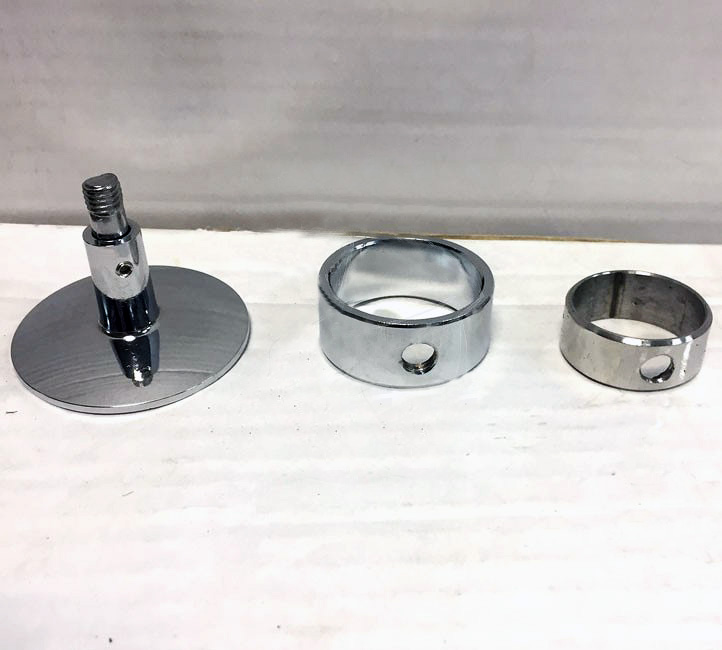
For the installation of heated towel rails, these are the most suitable fasteners that meet the requirements of GOST. The bracket is simple, the telescopic bracket is one-piece, and many others can be purchased at hardware stores. The appearance of the product is a ring on a leg, which can be divided. The first part of the structure is screwed onto the coil outlet - no further actions are required with this element.
The leg is fixed to the wall by means of anchors, screws, self-tapping screws. Then you only need to connect both parts. The brackets are made of brass, and to improve performance, protect against external factors, increase their attractiveness, they are nickel-plated and chrome-plated.

Telescopic brackets not only fix the heated towel rail on the wall, but also allow you to adjust the gap between them. A good option to simplify the installation of devices is a detachable telescopic mount.
One-piece supports
These fasteners, like their split counterparts, consist of a ring and a leg.The difference is that both parts are soldered together, which is inconvenient when mounting weighty structures. One-piece supports are rarely used.
Fitting types
Fittings are support elements made of steel, chrome-plated brass. It is part of the piping system that is installed on the hot water inlets and outlets. They are selected according to the configuration of the installed device, the place of its installation, the requirements of standards regarding the location of objects.

By design, fittings are:
- Taps are used to change the direction of the outlets of hot, cold water supply.
- The crosses are attached to the main pipes, providing two additional outlets for fixing the devices.
- Tees are installed on the main pipe, creating an additional outlet on it. They are used when installing the coil, if it was not there before.
- The corners allow you to rotate the outlet, inlet, 90 degrees.
- Collectors create an additional branch.
- Couplings are used to connect two pipes with the same diameter.
- The caps seal the pipes hermetically.
- The fittings are designed for connecting flexible hoses.
- Plugs are used to plug unnecessary leads.
- Reflectors protect the joints from moisture, and play a decorative role.
- Plugs close unused taps.
- Adapters are designed to connect two pipes with different diameters.
- The eccentrics compensate for the missing pipeline length.
- "American" - detachable connection in the form of a union nut.
Electric heated towel rail connection
Unlike the water analogue, the installation of an electric heated towel rail is completely unrelated to plumbing work. However, when connecting it, you still need to follow the rules:
- since the heated towel rail is a powerful electrical appliance, its connection should be made only to a line equipped with a circuit breaker;
- you cannot connect a heated towel rail on the same line with a water heater or washing machine;
- the heated towel rail must be grounded;
- if you plan to plug the appliance into an outlet in the bathroom, then it must be moisture resistant.
You can connect a heated towel rail in the bathroom only to a special socket
The very installation of the device is carried out using the same telescopic supports as in the previous case.
As you can see, installing a heated towel rail is not as difficult as it might seem at first glance. Of course, in the event that you have ready-made pipes for connecting it in your bathroom. Otherwise, it makes sense to entrust this work to professionals, although with the presence of certain tools and special skills, you can cope with this task yourself. Successful renovation!
Installation of a new heated towel rail
How to install a heated towel rail: stages
Installation and connection work is carried out in several stages:
- Cut off the water supply.
- Removing the old coil. If it is threaded to the riser, you must unscrew it with adjustable wrenches. If the dryer is welded to the riser, we simply cut it off together with the pipe using a turbine.
- Installation of ball valves, bulkheads.
- Screwing the Mayevsky tap into the bypass for comfortable air release of the system.
- Marking on the wall with a pencil places for future fixings. Exposition of horizontal marks using the level indicator.
- Drilling a hole according to special marks and driving a dowel into them.
How to install a new heated towel rail yourself
Having set the heated towel rail in such a way that the holes coincide, we fasten it with a regular screwdriver. Do not forget to maintain the required distance from the wall to the pipes. We adjust it if there is a bracket with a hairpin.
We use fittings for a reliable connection with the supply connections, as well as for the return of water. They are angular or straight.
It is important to seal the threads with tow or other winding. Fum can be used to seal tapered threads more reliably
When installing the device, set a small slope of the liner (from 5 to 10 mm). Tighten all union nuts, placing a cloth under the key in advance so that no scratches remain. Put special gaskets into the end of the nut. It is necessary to tighten smoothly and without great effort, if difficulties arise when turning the key - unscrew the connection, set the connecting elements evenly. After tightening the nut to the end, squeeze a little, but do not overdo it, so as not to disrupt the thread.
After completing the assembly, you can supply water to the heated towel rail. Open the water supply smoothly. Open the valve on the bulkhead slightly to release air from the pipes. When the water starts to drip, you can close it. Inspect thoroughly and iron all threaded joints and welds by hand to check for leaks.

